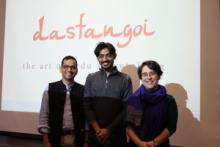On Thursday, November 5, 2015, the South Asia Center hosted a vibrant demonstration and discussion on the history of thedāstān genre, its main components as a form, its patronage (past and present), the reclaiming of the genre, and the journey of Ankit Chadha to becoming a dāstān-go (story-teller). This was followed by an engaging hour of dāstān-goʼī (story-telling) by Chadha, where he electrified the audience with his evocative and humorous narration and the remarkable range he demonstrated in his rendering of both the classic dāstān as well as of his own original compositions on themes of contemporary relevance.
In the dāstān-goʼī hour, Chadha enchanted the audience with four short narrations, two in the classic tradition and a few that echoed contemporary concerns. Chadha is also an Urdu enthusiast outside of his career as a dāstān-go. On his love for Urdu poetry, Chadha remarked: “An Urdu couplet makes for the best tweet!”
